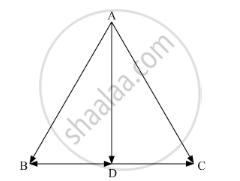Advertisements
Advertisements
प्रश्न
The two vectors `hatj+hatk " and " 3hati-hatj+4hatk` represent the two sides AB and AC, respectively of a ∆ABC. Find the length of the median through A
उत्तर
In ∆ABC,

Using the triangle law of vector addition, we have
`vec(BC)=vec(AC)-vec(AB)`
`=(3hati-hatj+4hatk)-(hatj+hatk)`
`=3hati-2hatj+3hatk`
`:.vec(BD)=1/2vec(BC)=3/2hati-hatj+3/2hatk " (Since AD is the median)"`
In ∆ABD, using the triangle law of vector addition, we have
`vec(AD)=vec(AB)+vec(BD)`
`=(hatj+hatk)+(3/2hati-hatj+3/2hatk)`
`=3/2hati+0hatj+5/2hatk`
`:.AD=sqrt((3/2)^2+0^2+(5/2)^2)=1/2sqrt34`
Hence, the length of the median through A is `1/2sqrt34`units.
APPEARS IN
संबंधित प्रश्न
If \[\vec{a,} \vec{b}\] are the position vectors of A, B respectively, find the position vector of a point C in AB produced such that AC = 3 AB and that a point D in BA produced such that BD = 2BA.
Show that the four points A, B, C, D with position vectors \[\vec{a,} \vec{b,} \vec{c,} \vec{d}\] respectively such that \[3 \vec{a} - 2 \vec{b} + 5 \vec{c} - 6 \vec{d} = 0,\] are coplanar. Also, find the position vector of the point of intersection of the line segments AC and BD.
Show that the four points P, Q, R, S with position vectors \[\vec{p}\], \[\vec{q}\], \[\vec{r}\], \[\vec{s}\] respectively such that 5 \[\vec{p}\] − 2 \[\vec{q}\] + 6 \[\vec{r}\] − 9 \[\vec{s}\] \[\vec{0}\], are coplanar. Also, find the position vector of the point of intersection of the line segments PR and QS.
The vertices A, B, C of triangle ABC have respectively position vectors \[\vec{a}\], \[\vec{b}\], \[\vec{c}\] with respect to a given origin O. Show that the point D where the bisector of ∠ A meets BC has position vector \[\vec{d} = \frac{\beta \vec{b} + \gamma \vec{c}}{\beta + \gamma},\text{ where }\beta = \left| \vec{c} - \vec{a} \right| \text{ and, }\gamma = \left| \vec{a} - \vec{b} \right|\]
Hence, deduce that the incentre I has position vector
\[\frac{\alpha \vec{a} + \beta \vec{b} + \gamma \vec{c}}{\alpha + \beta + \gamma},\text{ where }\alpha = \left| \vec{b} - \vec{c} \right|\]
Show that the line segments joining the mid-points of opposite sides of a quadrilateral bisects each other.
If the position vector of a point (−4, −3) be \[\vec{a,}\] find \[\left| \vec{a} \right|\]
If the position vector \[\vec{a}\] of a point (12, n) is such that \[\left| \vec{a} \right|\] = 13, find the value (s) of n.
If the position vectors of the points A (3, 4), B (5, −6) and C (4, −1) are \[\vec{a,}\] \[\vec{b,}\] \[\vec{c}\] respectively, compute \[\vec{a} + 2 \vec{b} - 3 \vec{c}\].
Show that the points 2 \[\hat{i}, - \hat{i}-4 \] \[\hat{j}\] and \[-\hat{i}+4\hat{j}\] form an isosceles triangle.
Find a unit vector in the direction of the resultant of the vectors
\[\hat{i} - \hat{j} + 3 \hat{k} , 2 \hat{i} + \hat{j} - 2 \hat{k} \text{ and }\hat{i} + 2 \hat{j} - 2 \hat{k} .\]
If \[\overrightarrow{PQ} = 3 \hat{i} + 2 \hat{j} - \hat{k}\] and the coordinates of P are (1, −1, 2), find the coordinates of Q.
Find the position vector of a point R which divides the line segment joining points \[P \left( \hat{i} + 2 \hat{j} + \hat{k} \right) \text{ and Q }\left( - \hat{i} + \hat{j} + \hat{k} \right)\] internally 2:1.
Find the position vector of a point R which divides the line segment joining points:
\[P \left( \hat{i} + 2 \hat{j} + \hat{k}\right) \text { and } Q \left( - \hat{i} + \hat{j} + \hat{k} \right)\] externally
Show that the points A, B, C with position vectors \[\vec{a} - 2 \vec{b} + 3 \vec{c} , 2 \vec{a} + 3 \vec{b} - 4 \vec{c}\] and \[- 7 \vec{b} + 10 \vec{c}\] are collinear.
Prove that the points having position vectors \[\hat{i} + 2 \hat{j} + 3 \hat{k} , 3 \hat{i} + 4 \hat{j} + 7 \hat{k} , - 3 \hat{i} - 2 \hat{i} - 5 \hat{k}\] are collinear.
If \[\vec{a,} \vec{b}\] are two non-collinear vectors prove that the points with position vectors \[\vec{a} + \vec{b,} \vec{a} - \vec{b}\text{ and }\vec{a} + \lambda \vec{b}\] are collinear for all real values of λ.
Show that the points whose position vectors are as given below are collinear:
\[2 \hat{i} + \hat{j} - \hat{k} , 3 \hat{i} - 2 \hat{j} + \hat{k} \text{ and }\hat{i} + 4 \hat{j} - 3 \hat{k}\]
Show that the points whose position vectors are as given below are collinear: \[3 \hat{i} - 2 \hat{j} + 4 \hat{k}, \hat{i} + \hat{j} + \hat{k}\text{ and }- \hat{i} + 4 \hat{j} - 2 \hat{k}\]
Show that the four points having position vectors
\[6 \hat{i} - 7 \hat{j} , 16 \hat{i} - 19 \hat{j} - 4 \hat{k} , 3 \hat{j} - 6 \hat{k} , 2 \hat{i} - 5 \hat{j} + 10 \hat{k}\] are coplanar.
Define position vector of a point.
If D is the mid-point of side BC of a triangle ABC such that \[\overrightarrow{AB} + \overrightarrow{AC} = \lambda \overrightarrow{AD} ,\] write the value of λ.
X and Y are two points with position vectors `3vec("a") + vec("b")` and `vec("a")-3vec("b")`respectively. Write the position vector of a point Z which divides the line segment XY in the ratio 2 : 1 externally.
Find the position vector of a point R which divides the line joining the two points P and Q with position vectors `vec"OP" = 2vec"a" + vec"b"` and `vec"OQ" = vec"a" - 2vec"b"`, respectively, in the ratio 1:2 externally
The position vector of the point which divides the join of points `2vec"a" - 3vec"b"` and `vec"a" + vec"b"` in the ratio 3:1 is ______.
Position vector of the mid-point of line segment AB is `3hati + 2hatj - 3hatk`. If position vector of the point A is `2hati + 3hatj - 4hatk`, then position vector of the point B is ______.
